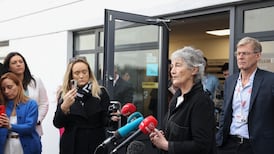Emergency departments around the country are expecting a “surge” of attendances once hazardous snow and ice conditions subside.
The post-storm jump is expected to see hospitals dealing with a mixture of people injured as a result of weather conditions as well as those with various other ailments who were unable to leave their homes.
Already, emergency departments have been treating fractures, dislocations and other injuries as a result of “trips and slips” in areas badly affected by the recent freeze but arrivals at national emergency departments have decreased overall.
Medics believe repeated warnings to the public to stay indoors has paid dividends in terms of reducing accidents.
Dr Emily O'Conor, a consultant at Connolly Hospital in Blanchardstown, Dublin and president of the Irish Association for Emergency Medicine (IAEM) told The Irish Times her emergency department had experienced about two thirds of the usual rate of attendances over the last 24 hours.
“While the blizzard is ongoing we would expect attendances to go down but once the roads begin to open up again we would expect a bit of an increase,” she said.
“People who have hung on at home and haven’t been able to get in will come [afterwards].
“There will be a rush. There will be people who would have attended in the last 24 hours but who haven’t been able to.”
Bank holidays
The situation is comparable to what hospitals deal with after bank holiday weekends. Once the snowy conditions dissipate, orthopaedic services are expected to be in particular demand to deal with fractures from falls.
Hospital staff are making particular effort to ensure there is sufficient cover. At Connolly, many in the emergency department have made “heroic efforts” to be in work, Dr Connolly said, even if they were not rostered to be there.
According to the Health Service Executive (HSE) emergency departments have seen a 10 to 30 per cent decrease in patient attendance rates, with sharper declines in areas worst affected by the storm.
National ambulance demand has remained constant however, at the normal rate of about 1,200 callouts per day.
In Cork, consultant in emergency medicine Dr Chris Luke, said while there was some cynicism generally about the level of warnings ahead of the blizzard, the message had worked and there were less injuries, and even fatalities, as a result.
“I know there was a bit of laughter but the truth is that we are getting better as a nation in dealing with major events,” he said.
“In the past we have had dozens [of injuries]in the one day. There is no doubt that the warnings and the reiterations have been beneficial. It has reduced the rate of accidents.”
Medics on trolleys
Emergency departments in Cork by lunchtime on Friday had experienced about half the normal daily rate of attendances.
Dr Luke said the State preparations and appeal to the public had “kept the health service intact because otherwise we could have had umpteen deaths”.
As with other hospitals, Cork medics were staying in hotels and on trolleys in hospitals to respond to any need, despite the ultimate decrease in cases.
Dr Luke also expects a surge in attendances once the “lag phase” passes with the storm.
“There will be a backlash. As soon as the weather becomes milder we will have a surge,” he said, referring to all types of cases. “The damn will burst.”
At Tallaght Hospital in Dublin, Dr Ciara Martin, consultant in paediatric emergency medicine, said while children have been coming in with broken bones from playing in the snow, the severity of conditions had kept the numbers relatively low.
“[We have seen] a couple of children with breaks but actually I think [the weather is] just too bad for them at the moment to be out,” she said.
“They were out on homemade sleds. We had a couple of kids using trays as sleds who came off them.”
Asthma, croup
Children have arrived with other ailments too, including severe asthma, croup and high temperatures.
The HSE’s national director of emergency management Damien McCallion said patients had been discharged ahead of the worst weather conditions, except in circumstances where there were concerns about their being isolated at home.
He said there would be about a four-day period after the storm of hospitals attempting to deal with an increase in patient attendances. After that, it will take about another 10 days for normal services, including elective procedures, to resume.
In the meantime, he said, staff had been “practically living in hospitals” to ensure cover.
Three local hotels had been occupied by medics from Tallaght Hospital. Elsewhere, temporary camp beds were set up for staff, who also slept on trolleys. At Beaumont Hospital about 120 stayed on campus or nearby in recent days, as well as about 100 at the Mater Hospital and in Cork University Hospital.
There have been cases of management teams helping out in kitchens and emergency transplants have been carried out at Beaumont Hospital. Order of Malta volunteers delivered blood supplies from Dublin to Galway on Thursday evening as the blizzard descended on Ireland.
Things were less severe in Donegal, where orthopaedic surgeon Dr Peter O’Rourke said there were no major issues as the county had not been badly affected by the weather.
However, clinics and surgeries had been cancelled. “It wasn’t a local decision, it was a national decision and it was totally unnecessary in Donegal,” he said.










